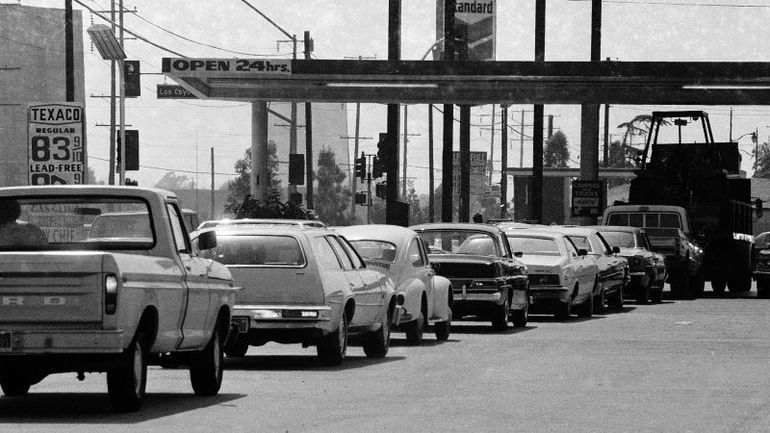
The Economy Today: Not as Dire as the 1970s

After recent data revealed a slowdown in US economic growth, concerns arose about a potential return to stagflation, reminiscent of the challenges faced in the 1970s. Despite current economic uncertainties, the situation today does not mirror the severity of that era.
Last month, new gross domestic product figures revealed that US economic growth had slowed from previous high levels. Many people interpreted this as a sign of stagflation, a condition where economic growth stagnates while inflation rises.
Stagflation is characterized by symptoms such as stagnant economic growth and increasing inflation. The recent inflation report for March, showing a surprising spike in prices, along with the lackluster GDP report, only seemed to confirm this diagnosis.
JPMorgan Chase CEO Jamie Dimon recently commented on the US economy, stating that it resembles the 1970s more than ever before and that there is a growing risk of stagflation.
However, Federal Reserve Chair Jerome Powell dismissed any concerns of stagflation, stating that he does not see any signs of stagflation during a press conference earlier this month after the Fed officials decided to keep interest rates unchanged.
I wasn't around during the time of stagflation, but I've heard about it. Stagflation in the 1970s was characterized by high unemployment, high inflation, and slow economic growth. This was mainly due to a spike in oil prices during the Arab oil embargo.
As a Gen Zer, I can't personally attest to that period. However, I do agree with Powell that the current state of the US economy is not stagflation. Instead, it might be facing a different, less severe condition known as slackflation.
What is slackflation?
If you’ve never heard that term before, there’s a good reason — I just coined it myself.
Slackflation is a frustrating situation that might make you want to reach out to your mom for advice. She might suggest going to urgent care, but you may choose to wait it out and see if it improves on its own or worsens.
In more economic terms, slackflation occurs when inflation remains steady, but not excessively high, and there is still unused resources in the economy. It's important to note that this term has nothing to do with the popular messaging app known for its wide range of emojis.
Economic slack is a term that describes when the economy is not doing as well as it could be. One common sign of economic slack is a higher unemployment rate.
In the latest jobs report, the US is experiencing some economic slack. However, the unemployment rate only increased slightly in April, from 3.8% in March to 3.9%. This is not a major cause for concern at the moment, but the situation could change soon.
One potential concern is the decrease in monthly job gains, dropping from 315,000 in March to 175,000 last month. However, Chicago Fed President Austan Goolsbee described April's gains as "very solid."
Additionally, there was an increase in applications for unemployment benefits last week, reaching the highest level since August.
But when it comes to inflation, the latest April Consumer Price Index figures, which were released on Wednesday, did show a slight improvement. Both the yearly and monthly price increases slowed down a bit.
However, Federal Reserve officials don't pay too much attention to the month-to-month changes in the inflation rate. They tend to focus more on the overall trend, as the saying goes in finance, "the trend is your friend." Unfortunately, the trend with inflation is not looking too favorable at the moment.
It seems like progress towards reaching the Fed's 2% target may be slowing down after some significant improvements in recent months. However, the current level of inflation is still much lower than what was experienced in the 1970s and 1980s.
So, why is there so much talk about stagflation?
Diane Swonk, chief economist at KPMG, explained it well.
She mentioned that unlike Powell, most of the labor force today did not experience stagflation in the past, so they do not have any memory of it.
Millennials, who make up a large portion of the workforce, are facing challenges in achieving important milestones. One of the key milestones is buying a home, which has become increasingly difficult due to high home prices and mortgage rates. As a result, many Americans have put off purchasing a home indefinitely. While times have changed since the 1970s, it is understandable why people may still feel frustrated.
Editor's P/S:
The ongoing economic situation sparks a mix of concern and optimism. While the term "stagflation" has been thrown around, the Federal Reserve seems confident in its absence. The reality may lie somewhere in between, with the economy experiencing a period of "slackflation." This term, coined by the author, describes a state of steady inflation coupled with underutilized economic resources.
It's understandable why many, particularly those who did not experience the stagflation of the 1970s, may feel a sense of unease. However, it's crucial to recognize that the current economic climate differs significantly from that era. While inflationary pressures persist, they remain below historical highs. Furthermore, the labor market shows signs of resilience, albeit with some softening in job growth. As the economy navigates these challenges, it's essential to remain vigilant, monitor key indicators closely, and adapt policy responses accordingly to prevent a more severe economic downturn.









